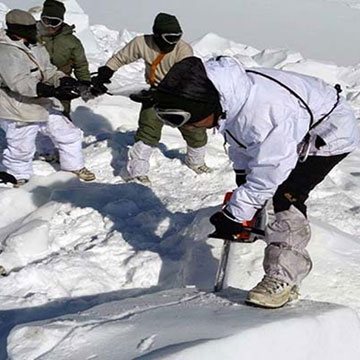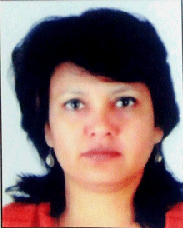 New Delhi:
New Delhi: After being miraculously rescued from under 35 feet of snow after an avalanche in the Siachen glacier region, Indian citizens have joined hands in praying for Lance Naik Hanamanthappa Koppad, who has been in a coma since his rescue on Tuesday.
Tears rolled down the face of the Indian Army General as he was informed on telephone that a soldier had been rescued alive almost a week after a kilometre-wide wall of ice buried an Army post in Siachen.
For the tough soldier with 30 years behind him of battle, hardship and losing men, this moment was a strong challenge to his customary stoicism. "Jolly good," he said briskly brushing away the tears though his voice betrayed his struggle to contain his emotions.
The avalanche struck on February 3. Lance Naik Hanamanthappa Koppad was found six days later, unconscious in his fibre-reinforced hut that was buried under the ice at the Sonam post, at an altitude of 19,600 feet in the Siachen glacier. Nine other soldiers lay dead beside him. Lance Naik Koppad is now in coma at an Army hospital in Delhi.
"We had a radio contact on February 4, one of the trapped soldiers reached out and we knew at least one of them was inside an air bubble," the General said. After that, the rescue efforts became even more frantic and desperate.
"The company commander did not leave the site for the last five days. Yet another deliberately survived on bits of chocolate because a full meal would slow him down," the senior officer said.
The rescue operation had to be stopped on February 5 because of snow storms and the officers did that very reluctantly. Logic said it was almost impossible for anyone to be alive for so long in those conditions, but the heart ruled. So they dug and dug and smashed through giant blocks of ice.
On February 3, the 10 soldiers at the Sonam post, one of the most critical posts of the Indian Army in the northern glacier, went out on a routine patrol. They returned and reported in at about 1.30 am.
At 3.30, they radioed to confirm that all was good.
By 5.30 am, the Sonam post did not exist, buried under the huge wall of ice 1,000 metres by 800 metres by 50 metres.
In the mission to rescue the soldiers, the Indian Army and Air Force flew 300 sorties, moving men and machines like ice cutters, thermal imagers and doppler radars, in broken-down condition, part by part.
The machines were reassembled at 19,600 ft and used to cut through the ice.
Siachen miracle:The miraculous rescue of Lance Naik Hanumanthappa Koppad was possible because he was trapped inside an air pocket under 35 feet of snow, and had access to oxygen ever since he was buried alive in an avalanche on February 3, Army officials said.
Army sources said Hanumanthappa was detected with the help of a radar, but rescue teams had little hope of “discovering him alive”.
About 150-200 personnel from nearby posts and units, including the 19 Madras regiment to which Hanumanthappa belongs, were engaged in round-the-clock rescue work since the avalanche.
The rescue teams, which also included two sniffer dogs, Dot and Misa, were equipped with radars, snow cutting equipment, medical equipment, Doppler radars and thermal detectors. They also had specialised digging and boring equipment, like rock drills, electrical saws and earth augers to break blue ice, which is harder than rock.
Of the 10 men who were buried in the avalanche that hit the Army post at Saltoro ridge on the northern glacier in Siachen, Hanumanthappa is the only one to have been rescued alive.
Army officers said the bodies of the jawans were scattered at different locations, and were detected with the help of their radio sets, which kept transmitting signals from beneath the snow. “As a practice, radio sets at the post are never switched off,” an Army official said.
Rescuers also used radars and thermal imagers, which indicate changes in the temperature of an area due to the presence of a human body. “It took the teams several tries to drill and reach Hanumanthappa’s exact location,” an official said.
When he was pulled out at 7.30 pm on Monday, his pulse was weak and he was drowsy and disoriented. He was immediately evacuated and treated at the post before being flown to Delhi via Thoise on Tuesday.
Hanumanthappa, who was was buried under a layer of snow 35 feet thick at a temperature of minus 45 degree Celsius, was “immediately resuscitated by doctors at the site, who had been there for the past five days in the hope of finding a survivor”.
“The credit goes to his willpower to survive and stay alive despite the sub-zero temperature,” an official said.
An Army doctor said he may have been inside a tent when the avalanche struck, which helped him keep warm under the snow.
Extreme weather conditions along with snow storms had slowed down rescue operation. “Moreover, at the height of 20,500 feet, where oxygen content is thin, physical efforts are limited. The teams are still deployed on the spot,” said an official.
According to a senior Army official, “We were lucky as we got three clear days, when a large number of sorties could take place.”
The rescue team was led by Commanding Officer of 19 Madras, who established a temporary camp at Sonam Post, where night temperatures hit minus 55 degree Celsius. The rescue team of 150 had to be deployed in rotation as each soldier needs to be rested after every 15 minutes due to low availability of oxygen at a high altitude.
The Army has recovered the bodies of the remaining nine soldiers. “They will be flown to the base camp and Thoise the moment weather opens up,” an official said.
 New Delhi: After being miraculously rescued from under 35 feet of snow after an avalanche in the Siachen glacier region, Indian citizens have joined hands in praying for Lance Naik Hanamanthappa Koppad, who has been in a coma since his rescue on Tuesday.
New Delhi: After being miraculously rescued from under 35 feet of snow after an avalanche in the Siachen glacier region, Indian citizens have joined hands in praying for Lance Naik Hanamanthappa Koppad, who has been in a coma since his rescue on Tuesday.